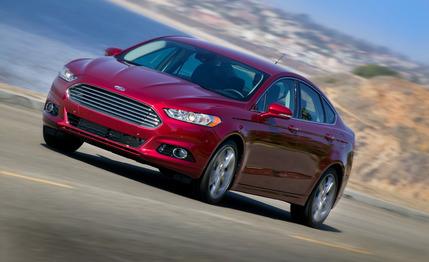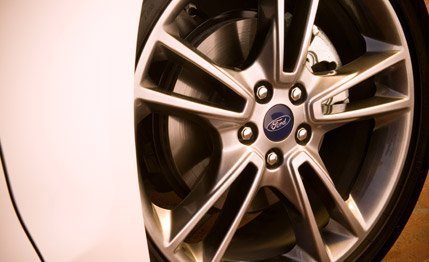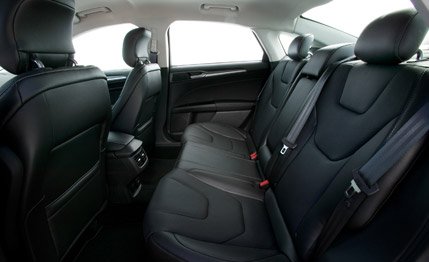 First Drive Review
First Drive Review
Like a heaping scoop of fried ice cream, the outside of the 2013 Ford Fusion is hot. The all-new car is easily the best looking mid-size four-door the company has ever built and maybe the best looking mainstream sedan yet from an American company. Yes, the grille looks like it was ripped off an Aston Martin, but the rest of the body is more sculpted than any Aston’s, with prominent character lines down the side and a stepped hood.
The profile, with its steeply raked windshield, sleek greenhouse, and near-fastback tail, is in the “four-door coupe” idiom pioneered by the Mercedes-Benz CLS and co-opted by the Kia Optima and Hyundai Sonata, among others. The car the new Fusion most resembles, however, is perhaps Audi’s A7 five-door, and that counts as high praise. In fact, the new four-door Fusion is so well detailed—the side mirrors seem inspired by the NFL’s Lombardi trophy—that it looks as if it could be a direct competitor to the $60,995 Audi. Instead, it starts at $22,495 and aims its cannons at the Honda Accord, Nissan Altima, Toyota Camry, and the Volkswagen Passat.
Besides being the Fusion here in America, this car will be sold as the Mondeo in Europe and may wear other names in other markets. But Ford insists it’s a one-spec car for the entire planet, which means that what gets built and sold as a Mondeo is virtually identical to what rolls out of the Hermosillo, Mexico, and Flat Rock, Michigan, plants that assemble the new Fusion for North America.

Under the stunning sheetmetal, the 2013 Fusion is a strictly conventional front- or all-wheel-drive, transverse engine, mid-size family car. The structure is a steel unibody, with a strut-type front suspension and a rear multilink setup. There’s a disc brake at each wheel, the steering is an electrically assisted rack-and-pinion system, and all the usual electronic nannies are aboard. While the particulars are standard for the segment, it is a truly new chassis that shares no stampings with either the previous Fusion or Mondeo. (It also serves as the basis for the even sleeker 2013 Lincoln MKZ.)
At an overall length of 191.7 inches, the new Fusion is only 0.3 inch longer than the 2013 Honda Accord. However, while the Accord runs on a 109.3-inch wheelbase, the Fusion’s stretches out to 112.2 inches. That’s a significant 2.9 inches longer, but it doesn’t show up in rear legroom. Honda claims 38.5 inches of rear-passenger leg space in the Accord, and Ford asserts 38.3 inches of legroom for second-row passengers in the Fusion. That said, the rear of the Accord feels larger than its numbers suggest, while the Fusion feels a smidge smaller. Maybe it’s all the black in our test cars, but the more likely culprits are the squirming required to fold yourself inside and the tighter greenhouse. Overall, Ford says a Fusion without a sunroof has 102.8 cubic feet of interior space while Honda claims 103.2 cubic feet for the Accord. Other minor nits: The Fusion’s small trunk opening could become an annoyance in everyday use, and its fuel tank is smaller than those of many of its competitors.

Engine Rundown
The least expensive 2013 Fusion models will be powered by the same naturally aspirated 175-hp, 2.5-liter four that was standard on the outgoing model. Ford didn’t have an example available at the press introduction in Santa Monica, California, instead serving up cars powered by the lineup’s turbocharged EcoBoost fours. There’s a 178-hp 1.6-liter that serves as an alternative to the base four, and a 240-hp 2.0-liter that effectively replaces the 240-hp, 3.0-liter V-6 that was offered in the previous Fusion.
A six-speed automatic transmission is standard with the base 2.5 and line-topping 2.0 turbo engines. The 1.6 turbo is available with either a six-speed manual or the six-speed automatic. The 2.0 turbo engine will power all Fusions equipped with the optional all-wheel-drive system. (The Fusion hybrid—both regular and plug-in varieties eventually will be offered—uses a belt-driven continuously variable transmission.)